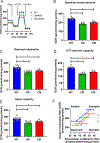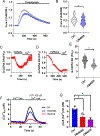Orai channel pharmacological manipulation reduces metabolic flexibility in cardiac fibroblasts
- PMID: 40298968
- PMCID: PMC12220785
- DOI: 10.1152/ajpcell.00822.2024
Orai channel pharmacological manipulation reduces metabolic flexibility in cardiac fibroblasts
Abstract
Cardiac fibroblasts (CFs) play a crucial role in regulating normal heart function and are also involved in the pathological remodeling of the heart that occurs due to hypertension, myocardial infarction, and heart failure. Metabolic changes in fibroblasts are key drivers in the progression of these diseases. Calcium (Ca2+) signaling and Ca2+ ion channels control many functions of fibroblasts. Orai Ca2+ channels are abundantly expressed in fibroblasts; however, their exact role is not yet fully understood. This study examined the role of Orai Ca2+ channels in maintaining Ca2+ homeostasis within organelles and in energy production in CFs. We found that chronic inhibition of Orai activity altered the expression levels of major metabolic enzymes, affecting the overall cell metabolism. Orai channels are required to refill the endoplasmic reticulum (ER) store. Acute Orai channel activity inhibition reduced Ca2+ content in the ER and mitochondria and was associated with the impaired ability to use glucose as a primary energy source. These results have significant implications for understanding the role of Orai-dependent Ca2+ entry in maintaining organellar Ca2+ homeostasis and cellular metabolic flexibility, sparking further research in this area.NEW & NOTEWORTHY We show that Orai actively contributes to organellar Ca2+ concentration and energy homeostasis of the cardiac fibroblast. These findings can have a significant impact during fibrogenesis.
Keywords: Orai; calcium; fibroblast; fibrosis; metabolism.
Conflict of interest statement
DISCLAIMERS
No conflicts of interest, financial or otherwise.
Figures






Similar articles
-
Discovery of selective Orai channel blockers bearing an indazole or a pyrazole scaffold.Eur J Med Chem. 2024 Nov 15;278:116805. doi: 10.1016/j.ejmech.2024.116805. Epub 2024 Aug 28. Eur J Med Chem. 2024. PMID: 39232360
-
Activated cardiac fibroblasts are a primary source of high-molecular-weight hyaluronan production.Am J Physiol Cell Physiol. 2025 Mar 1;328(3):C939-C953. doi: 10.1152/ajpcell.00786.2024. Epub 2025 Jan 27. Am J Physiol Cell Physiol. 2025. PMID: 39871135 Free PMC article.
-
Reduced membrane cholesterol limits pulmonary endothelial Ca2+ entry after chronic hypoxia.Am J Physiol Heart Circ Physiol. 2017 Jun 1;312(6):H1176-H1184. doi: 10.1152/ajpheart.00097.2017. Epub 2017 Mar 31. Am J Physiol Heart Circ Physiol. 2017. PMID: 28364016 Free PMC article.
-
EORTC guidelines for the use of erythropoietic proteins in anaemic patients with cancer: 2006 update.Eur J Cancer. 2007 Jan;43(2):258-70. doi: 10.1016/j.ejca.2006.10.014. Epub 2006 Dec 19. Eur J Cancer. 2007. PMID: 17182241
-
The correlation between mitochondria-associated endoplasmic reticulum membranes (MAMs) and Ca2+ transport in the pathogenesis of diseases.Acta Pharmacol Sin. 2025 Feb;46(2):271-291. doi: 10.1038/s41401-024-01359-9. Epub 2024 Aug 8. Acta Pharmacol Sin. 2025. PMID: 39117969 Review.
References
-
- Ebrahimighaei R, Tarassova N, Bond SC, McNeill MC, Hathway T, Vohra H, Newby AC, and Bond M. Extracellular matrix stiffness controls cardiac fibroblast proliferation via the nuclear factor-Y (NF-Y) transcription factor. Biochim Biophys Acta Mol Cell Res 1871: 119640, 2024. - PubMed
-
- Berridge MJ, Bootman MD, and Roderick HL. Calcium signalling: dynamics, homeostasis and remodelling. Nat Rev Mol Cell Biol 4: 517–529, 2003. - PubMed
-
- Crabtree GR. Calcium, calcineurin, and the control of transcription. The Journal of biological chemistry 276: 2313–2316, 2001. - PubMed
MeSH terms
Substances
Grants and funding
LinkOut - more resources
Full Text Sources
Miscellaneous

